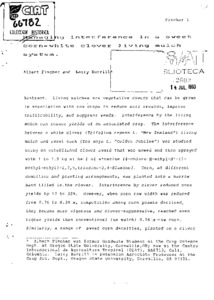Managing interference in a sweet corn-white clover living mulch system
Living mulches are vegetative covers that can be grown in association with row crops to reduce soil erosion, improve trafficability, and suppress weeds. Interference by the living mulch can reduce yields of an associated crop. The interference between a white clover (Trifolium repens L. "New Zealand") living mulch and sweet corn (Zea mays L. "Golden Jubilee") was studied using an established clover sward that was mowed and then sprayed with 1 to 1.5 kg ai ha-1 of atrazine [6-chloro-N-ethyl-N`-(l-methyl-ethyl)-1,3,5,triazine-2,4-diaminel. Corn, at different densities and planting arrangements, was planted into a narrow band tilled in the clover. Interference by clover reduced corn yields by 12 to 39 percent. However, when corn row width was reduced from 0.76 to 0.38 m, competition among corn plants declined, they became more vigorous and clover-suppressive, reached even higher yields than conventional (no mulch) 0.76-m-row corn. Similarly, a range of sweet corn densities, planted on a clover mulch killed by atrazine, yielded more in equidistant planting than in wide (0.76 m) rows. A near equidistant corn planting arrangement can, therefore, be a low-input alternative to achieve season-long clover suppression, and thus minimize its competition with the intercropped corn.

